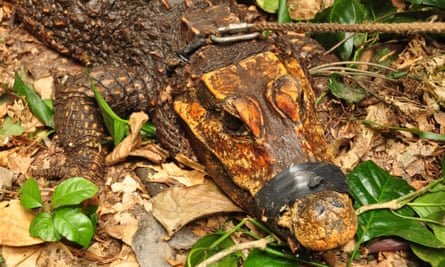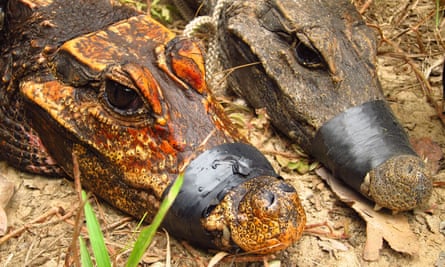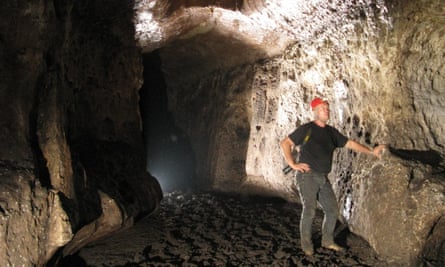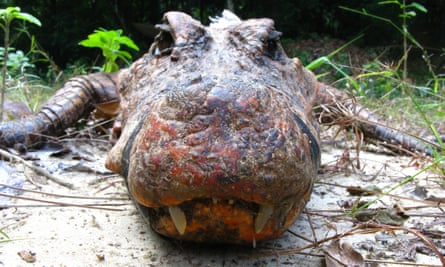It sounds like something out of a children’s book: it’s orange, it dwells in a cave and it lives on bats and crickets. But this isn’t some fairy story about a lonely troll – it’s the much weirder tale of a group of African dwarf crocodiles that are adapting to life in pitch-darkness.
“We could say that we have a mutating species, because [the cave crocodile] already has a different [genetic] haplotype,” said Richard Oslisly, who first discovered the cave crocs in 2008. “Its diet is different and it is a species that has adapted to the underground world.”
An archeologist who has long studied Gabon’s pre-history, Oslisly entered the Abanda Caves in Gabon looking for signs of past humans, such as rock paintings or engravings. Instead, he found crocodilians in a “great room…filled with water.”
Two years later he returned with cave scientist, Olivier Testa, and crocodile specialist, Matthew Shirley. They caught the first cave crocodile then – and when they carried it outside discovered that its skin was not the grey (almost bluish grey) of normal African dwarf crocodiles, but orange.

To date, the team has discovered a population of around thirty cave crocodiles, ten of which are orange, though more may remain hidden. The researchers believe that the juvenile crocodiles are able to go in-and-out of the cave system through various openings, but once the crocs hit a certain size they may in fact spend the rest of their days beyond the reach of the sun.
“They are somehow in their own prison,” Oslisly said. “They eat bats that live in these caves by the tens-of-thousands and also crickets that swarm the walls.”
Over time, these older crocodiles begin to turn orange. The researchers theorize that the colour change is due to the crocodiles spending so much time in an alkaline mix of water and bat guano, bleaching the croc’s skin.
Crocodiles are ectotherms – which means they need ambient heat in order to survive, let alone thrive. But, Oslisly says the cave crocodile’s conditions aren’t that different from the outdoor ones: they both hunt in the dark – African dwarf crocodiles are primarily nocturnal – and the temperatures in the cave waters is a stable and balmy 22 degrees Celsius (71 degrees Fahrenheit).
African dwarf crocodiles, which are found in West and Central Africa, are the world’s smallest, maxing out at less than two metres, though most never grow beyond 1.5. Long considered a single species, research over the last few years implies there may actually be three distinct species in the region – not including the bizarre cave crocs.
Intriguingly, genetic evidence to date suggests that the cave crocs may be splitting from their outside relatives. One of the haplotypes – a set of genes from one of their parents – of the cave crocodiles has not been found in the outside African dwarf crocodiles.
“The [crocodiles in the] caves of Abanda stand out as an isolated genetic group,” expalined Oslisly. He says that the data to date show this cave group split off thousands of years ago from its outdoorsy relatives.

But the DNA of the cave crocs raises the question: where are these animals breeding? The smaller ones may venture out of the caves to breed. But, if the largest crocodiles are truly stuck: do they nest inside the caves – a behavior that’s never been documented – or have they given up lovemaking altogether? African dwarf crocodiles usually require vegetation for their eggs, but there’s none of that in the caverns’ recesses. Or, instead, are the big crocs only utilizing the caves seasonally – and then find a way out to breed during the wet season?
The researchers believe that the crocodiles may be utlising the caves for a number of reasons, including its steady source of bats and crickets and safety from predators – namely us.
“We are lucky because local people are afraid to enter the caves,” Oslisly said.
Like so many other animals in Africa, the bushmeat trade is decimating crocodile populations. Dwarf crocodile meat is highly prized by locals, and the species is relatively easy to catch given its small size and the fact that its less aggressive than other crocodilians. They are currently categorised as vulnerable by the IUCN Red List, but if there are more than one species that could complicated matters.
Returning to the cave in 2015, the team discovered new cavern passages and documented that the orange, cave crocodiles were still hanging out in the darkness during the wet season.
Oslisly is now working with partners on turning the area into a wildlife sanctuary in order to protect these bizarre, mutating reptiles – the only place in the world where such behavior has ever been observed in crocodiles.






Comments (…)
Sign in or create your Guardian account to join the discussion